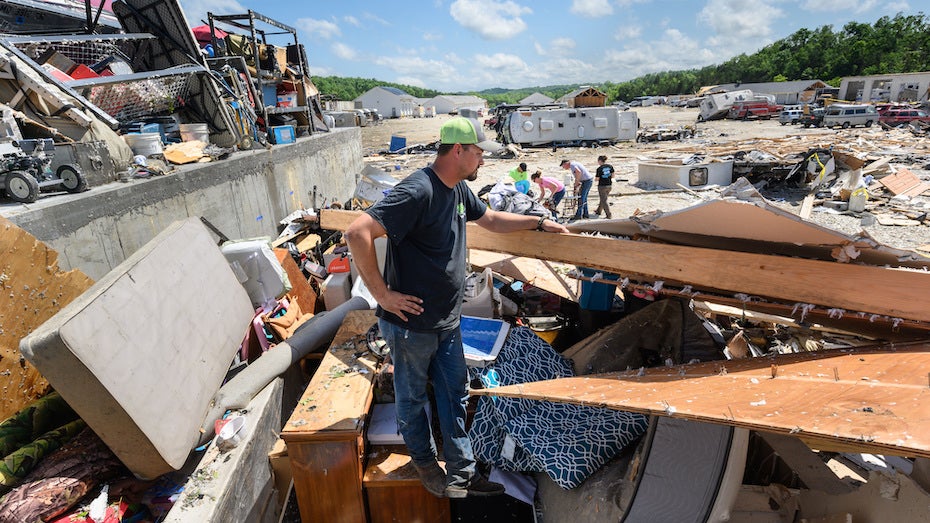Above: Dakota Libbert looks over what remains of this storage unit on May 23, 2019 in Jefferson City, Missouri. "We had everything in here but our clothes," said Libbert. Libbert and his family had sold their home and were storing all their belongings here while building a new home when a tornado hit on May 22. (Reed Hoffmann/Getty Images)
Note (March 3): Central Tennessee was hit by a long-track tornado supercell early Tuesday that left major damage in Nashville and nearby Putnam County. At least 19 deaths have been reported. We'll have more in a Cat 6 post later today. See weather.com for extensive coverage.
An idea that once seemed far-fetched—predicting U.S. tornado activity up to three weeks in advance—is steadily proving its mettle. A paper now online in early-release form and soon to appear in the Bulletin of the American Meteorological Society documents the performance of the Extended Range Tornado Activity Forecasts (ERTAF), which have been issued weekly during each storm season since 2015.
“[We] believe skillful predictions of U.S. tornado frequency at lead times of 2 and 3 weeks are operationally feasible with current tools and the current state of scientific knowledge,” wrote the paper’s authors.
This year’s first ERTAF forecast, issued on Sunday, March 1, calls for near-average activity during the periods March 8-14 and March 15-21. However, the team calls the forecast “low confidence” and notes some potential for severe weather early next week from the Arklatex region eastward.
Some severe weather is also possible in the shorter term, according to the NOAA/NWS Storm Prediction Center, whose daily convective outlooks extend out to eight days. SPC had a slight-risk area for Monday centered on the Mississippi Valley near Memphis, with very large hail a particular threat. Severe thunderstorms had bubbled up by Monday evening over southeast missouri, and a tornado watch was in effect from northwest Arkansas to far southwest Indiana.
Severe weather may also accompany a southern-stream storm system from southern Texas on Tuesday to northern Florida by Thursday. Heavy rain and flash flooding are a key concern; widespread tornado activity is not expected, although a few tornadoes will be possible.
How ERTAF works
ERTAF aims not to predict specific tornadoes, or even outbreak days, but rather to highlight multiday periods of enhanced tornado activity in a general sense. Such multiday outbreaks often feature the most extensive and destructive twister behavior.
There’s ample evidence that individual weather features, such as cold fronts or hurricanes, cannot be skillfully predicted beyond about two weeks. Research on this point goes back more than 50 years to Edward Lorenz’s pioneering work in chaos theory, and it extends to recent studies with high-end models.
At the same time, there is increasing interest in what can be said about conditions that might prevail or emerge beyond the two-week period, in the window often dubbed “subseasonal.” The NOAA/NWS Climate Prediction Center now issues 3-to-4-week temperature and experimental precipitation outlooks, and the National Academies published a report in 2016 examining the potential of subseasonal to seasonal (S2S) forecasts.
“There is great opportunity to further improve the skill of S2S forecasts, as well as the breadth of forecasted variables and routinely available forecast products,” said the National Academies report. “Doing so could dramatically increase the benefits of the environmental prediction enterprise: saving lives, protecting property, increasing economic vitality, protecting the environment, and informing policy choices.”
What makes a generalized three-week tornado outlook feasible is the influence of large-scale phenomena such as the Madden-Julian Oscillation (MJO), which have some limited predictability beyond the two-week window of day-to-day forecasting. Even if you can’t nail a local temperature or place a cold front with precision 18 days out, the ERTAF team argues, you can still ferret out clues as to whether continental-scale conditions will be more or less likely to favor severe weather at some point within a week-long period.
Each Sunday night from March to May (now extending into June), the ERTAF team releases a forecast for week-long periods starting on the following Sunday (Week 2) and the Sunday after that (Week 3).
The ERTAF format is simple: each week is tagged with the expectation of below average (BA), average (A), or above average (AA) tornado activity, compared to the long-term number of tornadoes (1985-2014) observed in that calendar period. These labels correspond, respectively, to less than 75%, 75 - 125%, or more than 125% of the long-term average.
To find out whether its forecasts were skillful, the ERTAF team—led by founder Victor Gensini (Northern Illinois University)—analyzed each Week 2 and Week 3 forecast issued in the years 2015–19. Using Heidke skill scores, an technique common in weather prediction, the team eliminated those forecasts that would have correct purely due to chance. The remaining forecasts can be deemed skillful if the Heidke skill score is greater than 0.
When considered in yearly groups, each year’s Week 2 forecasts were more skillful than chance alone, and considerably more skillful than a persistence approach (one that simply extends the activity level from the week that led up to the forecast issuance). Week 3 forecasts also beat chance and persistence by a large margin, except in 2018. (The study was unable to assess statistical significance because of the small number of forecasts issued since ERTAF began.)
“The driver of the poor performance for 2018 was a tendency for ERTAF forecasts to default to a forecast of A [average] due to the absence of strong signals from the leading modes of variability,” noted Gensini and colleagues. “This resulted in a lower success rate in the face of many BA [below-average] verifications.”
One particular success came with ERTAF’s long-range forecast of an enhanced period of tornado activity in late May 2019. As early as its April 28 outlook, the team noted that model ensembles were suggesting that the Madden-Julian Oscillation would progress from the Indian Ocean into the eastern Pacific in early to mid-May, which in turn would favor a severe-weather-stoking jet-stream breakthrough into the United States. On May 5, the team called for above-average tornado activity in Week 3 (May 19-25), and it reiterated that thinking a week later in the Week 2 outlook (although the Week 2 and 3 forecasts for May 26 to June 2 were both “average”). The period from May 17 to 30 ended up spawning more than 390 U.S. tornadoes, including a record stretch of 13 consecutive days with at least one tornado. The twisters led to at least eight fatalities and left widespread damage in southwest and central Missouri on May 22, several locations in Ohio on May 27, and northeast Kansas on May 28.
Behind the scenes
The ERTAF team calls on a variety of analyses of global atmospheric behavior, including output from multiple model ensembles. Week 2 forecasts draw on the outer periods of standard weather forecast models, such as the GFS and ECMWF, while Week 3 forecasts lean more heavily on seasonal forecast models that incorporate oceanic features, such as NOAA’s CFSv2 model.
A particular focus for the group is atmospheric angular momentum—how fast the atmosphere is spinning relative to Earth’s rotation. This variable helps diagnose where and when upper-level jet energy is progressing eastward across the globe or getting stalled in place for prolonged periods. The presence of a strong upper jet is crucial in providing the wind shear needed for major and/or prolonged periods of tornadoes. (See this YouTube presentation for more on atmospheric angular momentum and two tools often used to analyze and display it: the Global Synoptic Dynamic Model and the Global Wind Oscillation graphic.)
“I think it's a great initiative by this group to begin to explore the predictability of severe weather regimes at subseasonal lead times,” said Michael Ventrice, subseasonal forecasting lead for The Weather Company. “There's connections with the tropics and extratropical circulation, as we are now shining light on in the community. The tropics can at times, modulate the Pacific jet, which is important for severe weather in the U.S.”
Ventrice added: “It's important to keep in mind there's still limitations in the predictability of these events. For the prediction of tornadoes at sub-seasonal leads, it's nearly impossible to precisely say where the outbreak will take place, though you can use climatology as a buffer zone.”
The forecasts itself are produced in an expert-judgment manner from a “virtual map room” conference call each Sunday night. Ventrice has participated in several ERTAF calls, discussing aspects of tropical variability such as Kelvin waves and the MJO. “I thought they were enjoyable—just a bunch of smart weather brains chatting about the weather and advanced meteorological metrics. We need to do more of these types of engagements in the field. It's a quick way to transfer knowledge and build ties in the community.”
According to Gensini, the weekly conference calls include “lots of discussion, and occasionally some disagreement, but I think given the experience of all of us, it’s usually a healthy ensemble-style picture of what’s possible.”
How might ERTAF forecasts be put to best use? “I've always been under the impression that a normal consumer is not going to change the way she/he behaves given a week 2 forecast of AA conditions,” Gensini said. “However, it is quite easy to see how these forecasts might benefit emergency managers, insurance companies, administrators, FEMA, etc.”



